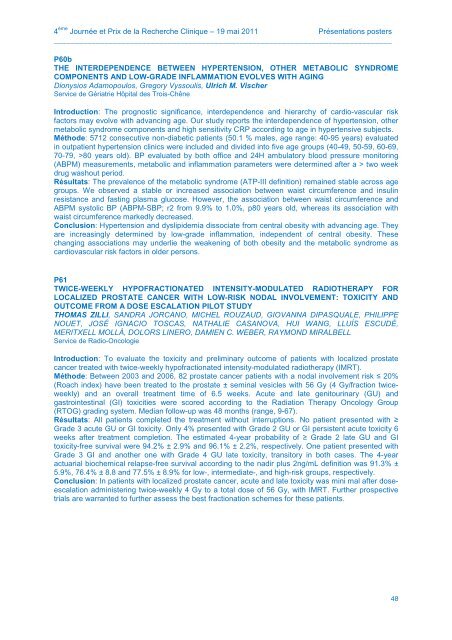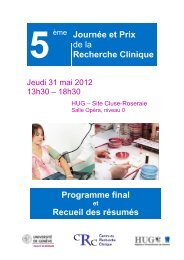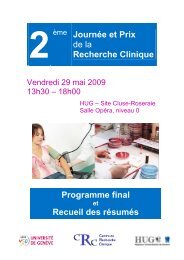Programme final et Recueil des résumés - Centre de recherche ...
Programme final et Recueil des résumés - Centre de recherche ...
Programme final et Recueil des résumés - Centre de recherche ...
Create successful ePaper yourself
Turn your PDF publications into a flip-book with our unique Google optimized e-Paper software.
4 ème Journée <strong>et</strong> Prix <strong>de</strong> la Recherche Clinique – 19 mai 2011 Présentations posters<br />
________________________________________________________________________________<br />
P60b<br />
THE INTERDEPENDENCE BETWEEN HYPERTENSION, OTHER METABOLIC SYNDROME<br />
COMPONENTS AND LOW-GRADE INFLAMMATION EVOLVES WITH AGING<br />
Dionysios Adamopoulos, Gregory Vyssoulis, Ulrich M. Vischer<br />
Service <strong>de</strong> Gériatrie Hôpital <strong><strong>de</strong>s</strong> Trois-Chêne<br />
Introduction: The prognostic significance, inter<strong>de</strong>pen<strong>de</strong>nce and hierarchy of cardio-vascular risk<br />
factors may evolve with advancing age. Our study reports the inter<strong>de</strong>pen<strong>de</strong>nce of hypertension, other<br />
m<strong>et</strong>abolic syndrome components and high sensitivity CRP according to age in hypertensive subjects.<br />
Métho<strong>de</strong>: 5712 consecutive non-diab<strong>et</strong>ic patients (50.1 % males, age range: 40-95 years) evaluated<br />
in outpatient hypertension clinics were inclu<strong>de</strong>d and divi<strong>de</strong>d into five age groups (40-49, 50-59, 60-69,<br />
70-79, >80 years old). BP evaluated by both office and 24H ambulatory blood pressure monitoring<br />
(ABPM) measurements, m<strong>et</strong>abolic and inflammation param<strong>et</strong>ers were d<strong>et</strong>ermined after a > two week<br />
drug washout period.<br />
Résultats: The prevalence of the m<strong>et</strong>abolic syndrome (ATP-III <strong>de</strong>finition) remained stable across age<br />
groups. We observed a stable or increased association b<strong>et</strong>ween waist circumference and insulin<br />
resistance and fasting plasma glucose. However, the association b<strong>et</strong>ween waist circumference and<br />
ABPM systolic BP (ABPM-SBP; r2 from 9.9% to 1.0%, p80 years old, whereas its association with<br />
waist circumference markedly <strong>de</strong>creased.<br />
Conclusion: Hypertension and dyslipi<strong>de</strong>mia dissociate from central obesity with advancing age. They<br />
are increasingly d<strong>et</strong>ermined by low-gra<strong>de</strong> inflammation, in<strong>de</strong>pen<strong>de</strong>nt of central obesity. These<br />
changing associations may un<strong>de</strong>rlie the weakening of both obesity and the m<strong>et</strong>abolic syndrome as<br />
cardiovascular risk factors in ol<strong>de</strong>r persons.<br />
P61<br />
TWICE-WEEKLY HYPOFRACTIONATED INTENSITY-MODULATED RADIOTHERAPY FOR<br />
LOCALIZED PROSTATE CANCER WITH LOW-RISK NODAL INVOLVEMENT: TOXICITY AND<br />
OUTCOME FROM A DOSE ESCALATION PILOT STUDY<br />
THOMAS ZILLI, SANDRA JORCANO, MICHEL ROUZAUD, GIOVANNA DIPASQUALE, PHILIPPE<br />
NOUET, JOSÉ IGNACIO TOSCAS, NATHALIE CASANOVA, HUI WANG, LLUÍS ESCUDÉ,<br />
MERITXELL MOLLÀ, DOLORS LINERO, DAMIEN C. WEBER, RAYMOND MIRALBELL<br />
Service <strong>de</strong> Radio-Oncologie<br />
Introduction: To evaluate the toxicity and preliminary outcome of patients with localized prostate<br />
cancer treated with twice-weekly hypofractionated intensity-modulated radiotherapy (IMRT).<br />
Métho<strong>de</strong>: B<strong>et</strong>ween 2003 and 2006, 82 prostate cancer patients with a nodal involvement risk ≤ 20%<br />
(Roach in<strong>de</strong>x) have been treated to the prostate ± seminal vesicles with 56 Gy (4 Gy/fraction twiceweekly)<br />
and an overall treatment time of 6.5 weeks. Acute and late genitourinary (GU) and<br />
gastrointestinal (GI) toxicities were scored according to the Radiation Therapy Oncology Group<br />
(RTOG) grading system. Median follow-up was 48 months (range, 9-67).<br />
Résultats: All patients compl<strong>et</strong>ed the treatment without interruptions. No patient presented with ≥<br />
Gra<strong>de</strong> 3 acute GU or GI toxicity. Only 4% presented with Gra<strong>de</strong> 2 GU or GI persistent acute toxicity 6<br />
weeks after treatment compl<strong>et</strong>ion. The estimated 4-year probability of ≥ Gra<strong>de</strong> 2 late GU and GI<br />
toxicity-free survival were 94.2% ± 2.9% and 96.1% ± 2.2%, respectively. One patient presented with<br />
Gra<strong>de</strong> 3 GI and another one with Gra<strong>de</strong> 4 GU late toxicity, transitory in both cases. The 4-year<br />
actuarial biochemical relapse-free survival according to the nadir plus 2ng/mL <strong>de</strong>finition was 91.3% ±<br />
5.9%, 76.4% ± 8.8 and 77.5% ± 8.9% for low-, intermediate-, and high-risk groups, respectively.<br />
Conclusion: In patients with localized prostate cancer, acute and late toxicity was mini mal after doseescalation<br />
administering twice-weekly 4 Gy to a total dose of 56 Gy, with IMRT. Further prospective<br />
trials are warranted to further assess the best fractionation schemes for these patients.<br />
48






